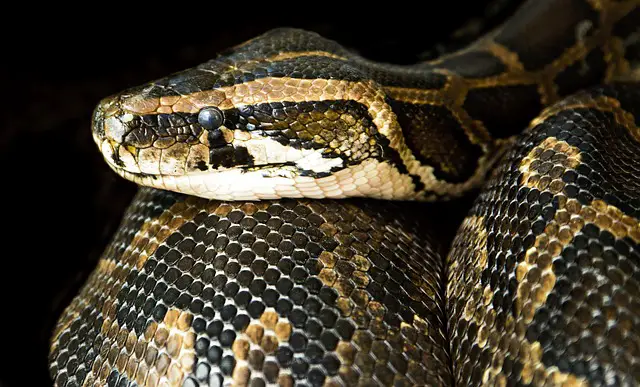An exquisite dinner in the wild can be haunting for some. Reptile enthusiasts are no strangers to the fascinating world of predators and their prey. However, while we often appreciate the beauty and majesty of owning a reptile, we may not fully understand the intricate details of their feeding habits.
The animal world has mind-boggling traits that keep predators and their prey alive. In this blog post, we’ll explore the various methods that predators (especially those in reptile species) use to consume their prey, highlighting some of the more gruesome and odd ways on display in the world of reptiles.
What is the nastiest way that predators consume their prey?
Predatory behavior can be shocking, especially regarding the nastiest ways of consuming prey.
Nowhere is this more evident than in lizards and reptiles, where cannibalism and neck-biting are commonly observed.
The reptile striking its prey with full force before consuming typically means that the animal has been taken by surprise; however, if a snake captures multiple small animals, it may bite its victims in half while they are still alive to make them easier to swallow.
This method of rough consumption is not for the faint of heart.
Slow and Steady Savagery: The Boa Constrictor
As a reptile and lizard expert, I have seen many forms of predation, however none as insidious and truly nasty as the method employed by boa constrictors.
They hunt their prey with slow and steady savagery, approaching quietly and coiling their bodies around it to suffocate it.
As these serpents face down to pin down their victim, they tighten their grip gradually around the unfortunate creature below.
Boa constrictors have been known to hold onto their meal for minutes until the prey runs out of breath due to a lack of circulation caused by the snake’s constricting coils.
This slow death is extensively studied in nature: fascinating in its unique form and undeniably quite grisly.
Chemical Warfare: Invenomation
As a reptile and lizard expert, I can say that one of the nastiest ways that predators consume their prey I have encountered is through invenomation.
Invenomation is deploying venom to incapacitate or kill one’s prey.
Examples of this occur in nature, where snakes, spiders, and lizards use their venom to instantly capture their target’s attention as an effective way to hunt them down.
Such creatures utilize this biochemical weapon to ensure a safe food source for themselves or their young.
Despite its efficacy being handy for these predators, it is an incredibly unpleasant sight to witness – and any living thing unfortunate enough to be exposed to it may suffer dire consequences.
Death by Dissolution: The Alligator Snapping Turtle
If you’re looking for nastiness in the predator-prey relationship, it’s hard to look past the alligator snapping turtle.
Unlike many other predators, these remarkable reptiles don’t just consume their prey – they dissolve it! Instead of biting, they press forward with a particular appendage from the roof of their mouth.
This part is covered in rough bumps and follicles that act like sandpaper to scrape away their prey until it dissolves into nothingness.
It’s grim (not to mention slimy), but it’s also an efficient way for them to capture and consume surprisingly small and large meals.
Alligator snappers are truly extraordinary animals worth checking out – make sure you watch your hands when you do.
Shock and Awe: The Cone Snail
I can safely say that no predator holds the title of nastiest prey consumption technique quite like the cone snail.
This small mollusk packs a bigger punch than one might think, boasting a potent venom that it uses to paralyze its unsuspecting prey.
The cone snail grasps its target with its radular teeth before hurling its paralyzed body into the digestive cavity, consuming it in a single gulp.
The efficiency of this shocking and awe-inspiring spectacle is what truly earns the cone snail its title of ‘nastiest’ because not only does it consume its prey quickly and with deadly force, but it does so without leaving a trace behind – making us admirers sometimes forget that death is involved at all.
Drowning Dinner: The Crocodile
One of the nastiest ways predators consume their prey is the crocodile‘s method of drowning dinner. It’s a gruesome event watched by countless victims over millions of years.
The reptilian monster will often surprise them from beneath the water, jaws wide open, and then drag them down under until the victim stops flailing against its crushing grip.
Life is sucked from its victim in an unfeeling and shocking feast of flesh, but as a reptile and lizard expert, I can only wonder at the unblinking tenacity with which this mega predator finishes a meal.
Hunger is so deep that it forces its sometimes hefty prey into submission before dragging it to oblivion. That is genuinely something terrifying to behold.
Conclusion
As reptile enthusiasts or those who appreciate the wilder side of life, it is essential to acknowledge that the animal kingdom is home to a wide array of predatory behaviors.
From constricting prey to death, injecting lethal venom, or drowning them in water, these diverse and gruesomely fascinating methods have evolved to maximize success while ensuring the predator’s survival.
Although it may pale in comparison to the hunting methods of mammals or birds, reptiles have honed their feeding habits over millions of years, reigning as silent and deadly masters of the art of predation.




